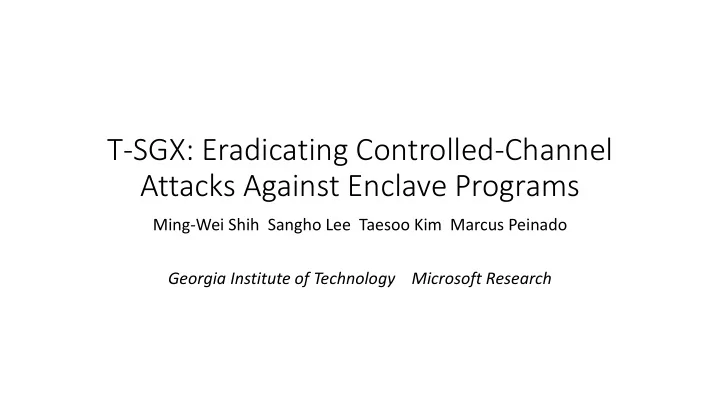

T-SGX: Eradicating Controlled-Channel Attacks Against Enclave Programs Ming-Wei Shih Sangho Lee Taesoo Kim Marcus Peinado Georgia Institute of Technology Microsoft Research
2
3
Intel SGX aims to secure users’ code and data in the cloud 4
Controlled-channel attack [Oakland 2015] raises concerns • An accurate side-channel attack that extracts the SGX-protected data • Compromise the security guarantees of SGX OS SGX CPU 5
How the attack works (1/3) • Intel SGX protects enclaves against an untrusted OS • SGX still relies on the OS for resource management Enclave (e.g., memory mapping) OS Page Table SGX CPU 6
How the attack works (2/3) • Attacker fully controls the OS • Page-fault side channel Page C • Step 1: Unmap a page • Step 2: Enclave accesses the page • Step 3: Observe a page fault page fault Page Table A B C D E SGX CPU 7
How the attack works (3/3) • If the program’s memory accesses depend on a secret , then this secret is being leaked Page A • Attack steps Page C Page B • Offline analysis • Obtain page-fault sequence page fault • Infer the secret Page D Page Table A B C D E … SGX CPU 8
T-SGX Goals • Prevent the controlled-channel attack • The design should be practical • No hardware modification • Reasonable performance • Minimal developer effort (no need for program rewritten) 9
Intel TSX Program • CPU extension present in all recent Intel CPUs (since 2013) race condition XBEGIN • Supports hardware transactional memory Transaction XEND abort • Race conditions cause transaction abort Fallback code • An abort triggers fallback execution • Rolls back all changes • Control transfers to the fallback point 10
Idea: Intel TSX also suppresses page faults Program • CPU does not deliver page faults to the OS Page fault • Instead, it aborts the transaction and XBEGIN invokes the fallback code Transaction XEND • OS cannot observe the page fault abort inside a transaction Fallback code 11
The strawman design • Make the whole enclave Enclave Program as a transaction Page fault XBEGIN • Enable the self-detection to page faults inside the enclave Transaction abort XEND Fallback code 12
Challenges Single transaction cannot be too large, otherwise it will never complete OS Timer Enclave Program XBEGIN Cache time constraint Timer interrupt cache constraint Transaction … Cache full abort abort XEND Fallback code 13
Solution: Break a program into execution blocks Execution Time analysis Cache analysis OS Timer Enclave Program Cache time constraint Execution Block cache constraint … Fallback code 14
Optimization: merging tiny blocks (1/2) • Problem : Setting up transaction comes with a fixed cost (~200 cycles) • If continuous blocks satisfy the cache and time constraints, we merge them • Loops • If-else statement • Functions 15
Optimization: merging tiny blocks (2/2) • Example: Loop optimization for (i = 1; i < 1000; i++) { XBEGIN XBEGIN for (i = 1; i < 1000; i++) { … … XEND } } XEND Requires only 1 transaction! Requires 1000 transactions Conservative static analysis • Only optimize when it’s safe 16
This design still leaks information Execution Blocks TSX instructions are outside of a transaction XBEGIN XEND Page A Page fault Page A Page B Page B 17
Solution: Springboard design Execution Blocks All transactions begin and end on the springboard • Attacker can only observe page fault on the springboard Springboard page Page A Springboard page Page fault Fallback code Page B Leak only single-page information! 18
Springboard design also prevents advanced attacks Execution Blocks Counting the number of page faults on springboard • May still leak information Page A Page A Page B , Page fault, Page fault Page fault Springboard page Fallback code Page B By design, the attack is impractical! (See paper for details) 19
Implementation: T-SGX • Based on the LLVM compiler • Mostly modifying LLVM backend • 4,100 line of code • Fully automated program transformation 20
Evaluation • How general is the T-SGX approach? • How much overhead does a transformed program have? 21
T-SGX works for general C/C++ programs Application Line of Code • 0 lines of source code change Numeric sort 211 String sort 521 Bitfield 225 • Fully-automated compiling Fp emulation 1,396 chain Fourier 235 Assignment 490 Idea 353 Huffman 448 Neural net 746 Lu decomposition 441 Libjpeg 34,763 Hunspell 24,794 FreeType 135,528 22
T-SGX incurs reasonable overhead • Average 30% memory overhead • Additional instructions for each execution block Benchmark programs 1.4 1.35 1.3 1.25 1.2 1.15 1.1 1.05 1 23 T-SGX
T-SGX incurs reasonable overhead • Average 50% runtime overhead (geometric mean) • Largely depends on number of loop iterations that repeatedly start a transaction 2.5 2 1.5 1 0.5 0 24 T-SGX
Consistent runtime overhead on concurrent execution 25
Conclusion • We proposed and implemented T-SGX, which effectively protects enclaves against the controlled-channel attack. • T-SGX • Requires no hardware modification • Incurs reasonable runtime overhead and still has potential to improve (e.g., using more advanced program analysis or performance profiling) • Automatically transforms a program without the need for manual effort 26
Q&A 27
Recommend
More recommend